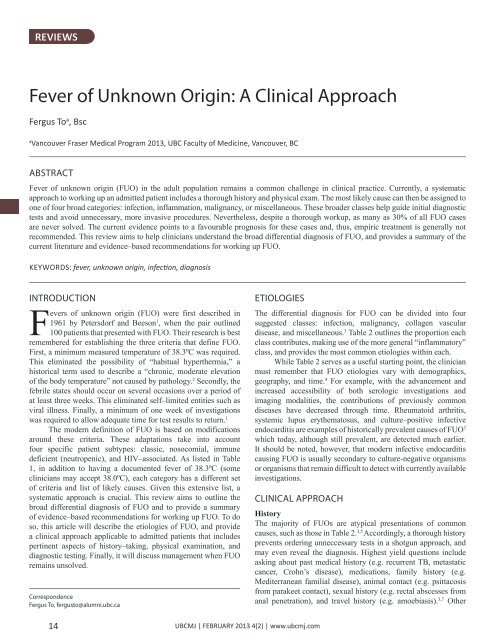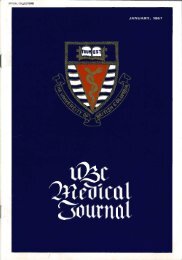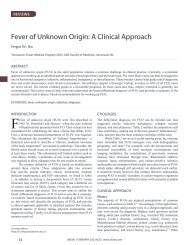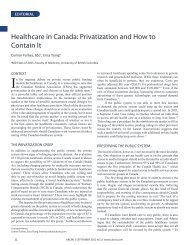Download full PDF - UBC Medical Journal
Download full PDF - UBC Medical Journal
Download full PDF - UBC Medical Journal
You also want an ePaper? Increase the reach of your titles
YUMPU automatically turns print PDFs into web optimized ePapers that Google loves.
REVIEWS<br />
Fever of Unknown Origin: A Clinical Approach<br />
Fergus To a , Bsc<br />
a<br />
Vancouver Fraser <strong>Medical</strong> Program 2013, <strong>UBC</strong> Faculty of Medicine, Vancouver, BC<br />
ABSTRACT<br />
Fever of unknown origin (FUO) in the adult population remains a common challenge in clinical practice. Currently, a systematic<br />
approach to working up an admitted patient includes a thorough history and physical exam. The most likely cause can then be assigned to<br />
one of four broad categories: infection, inflammation, malignancy, or miscellaneous. These broader classes help guide initial diagnostic<br />
tests and avoid unnecessary, more invasive procedures. Nevertheless, despite a thorough workup, as many as 30% of all FUO cases<br />
are never solved. The current evidence points to a favourable prognosis for these cases and, thus, empiric treatment is generally not<br />
recommended. This review aims to help clinicians understand the broad differential diagnosis of FUO, and provides a summary of the<br />
current literature and evidence–based recommendations for working up FUO.<br />
KEYWORDS: fever, unknown origin, infection, diagnosis<br />
INTRODUCTION<br />
Fevers of unknown origin (FUO) were first described in<br />
1961 by Petersdorf and Beeson 1 , when the pair outlined<br />
100 patients that presented with FUO. Their research is best<br />
remembered for establishing the three criteria that define FUO.<br />
First, a minimum measured temperature of 38.3ºC was required.<br />
This eliminated the possibility of “habitual hyperthermia,” a<br />
historical term used to describe a “chronic, moderate elevation<br />
of the body temperature” not caused by pathology. 2 Secondly, the<br />
febrile states should occur on several occasions over a period of<br />
at least three weeks. This eliminated self–limited entities such as<br />
viral illness. Finally, a minimum of one week of investigations<br />
was required to allow adequate time for test results to return. 1<br />
The modern definition of FUO is based on modifications<br />
around these criteria. These adaptations take into account<br />
four specific patient subtypes: classic, nosocomial, immune<br />
deficient (neutropenic), and HIV–associated. As listed in Table<br />
1, in addition to having a documented fever of 38.3ºC (some<br />
clinicians may accept 38.0ºC), each category has a different set<br />
of criteria and list of likely causes. Given this extensive list, a<br />
systematic approach is crucial. This review aims to outline the<br />
broad differential diagnosis of FUO and to provide a summary<br />
of evidence–based recommendations for working up FUO. To do<br />
so, this article will describe the etiologies of FUO, and provide<br />
a clinical approach applicable to admitted patients that includes<br />
pertinent aspects of history–taking, physical examination, and<br />
diagnostic testing. Finally, it will discuss management when FUO<br />
remains unsolved.<br />
Correspondence<br />
Fergus To, fergusto@alumni.ubc.ca<br />
ETIOLOGIES<br />
The differential diagnosis for FUO can be divided into four<br />
suggested classes: infection, malignancy, collagen vascular<br />
disease, and miscellaneous. 3 Table 2 outlines the proportion each<br />
class contributes, making use of the more general “inflammatory”<br />
class, and provides the most common etiologies within each.<br />
While Table 2 serves as a useful starting point, the clinician<br />
must remember that FUO etiologies vary with demographics,<br />
geography, and time. 4 For example, with the advancement and<br />
increased accessibility of both serologic investigations and<br />
imaging modalities, the contributions of previously common<br />
diseases have decreased through time. Rheumatoid arthritis,<br />
systemic lupus erythematosus, and culture–positive infective<br />
endocarditis are examples of historically prevalent causes of FUO 3<br />
which today, although still prevalent, are detected much earlier.<br />
It should be noted, however, that modern infective endocarditis<br />
causing FUO is usually secondary to culture-negative organisms<br />
or organisms that remain difficult to detect with currently available<br />
investigations.<br />
CLINICAL APPROACH<br />
History<br />
The majority of FUOs are atypical presentations of common<br />
causes, such as those in Table 2. 3,5 Accordingly, a thorough history<br />
prevents ordering unneccessary tests in a shotgun approach, and<br />
may even reveal the diagnosis. Highest yield questions include<br />
asking about past medical history (e.g. recurrent TB, metastatic<br />
cancer, Crohn’s disease), medications, family history (e.g.<br />
Mediterranean familial disease), animal contact (e.g. psittacosis<br />
from parakeet contact), sexual history (e.g. rectal abscesses from<br />
anal penetration), and travel history (e.g. amoebiasis). 3,7 Other<br />
14<br />
<strong>UBC</strong>MJ | FEBRUARY 2013 4(2) | www.ubcmj.com










